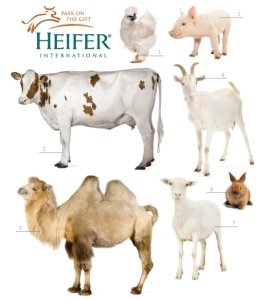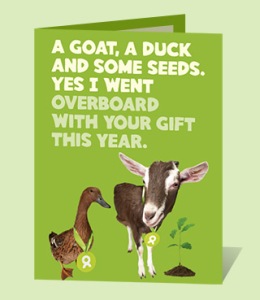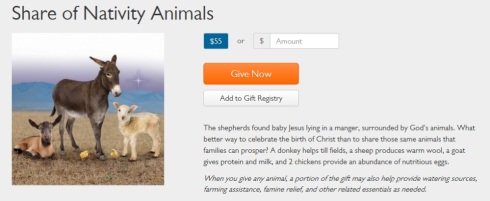With some big gift-giving holidays coming up, I’m posting this excerpt fromBleating Hearts, in which I expose the popular practice of giving animals as a way to alleviate hunger and poverty.
 The concept sounds wonderful to many people: Help end hunger by providing a farmed animal to an impoverished family. Every November, just in time for the holidays, the mailboxes of compassionate people in developed nations become stuffed with glossy pleas from a seemingly endless procession of give-a-cow nonprofits, some endorsed by celebrities and all asking you to donate funds that will supply animals to the poor. For US$75, World Vision will send a needy family a goat, or a donation of US$30 will buy them five ducks. Harvest of Hope, meanwhile, offers a bull, plow, and seeds for a Ghanaian farmer for US$850, and US$45 will buy a pig whose “offspring are raised and sold for a profit, giving a family a steady source of income,” reads the catalog. A Heifer International catalog encourages grandparents to donate the cost of rabbits (US$60) in honor of their granddaughter’s first Christmas. “What better way to share the joy you see in the eyes of such a healthy, happy little girl than to make a gift in her name that can help provide a trio of bunny rabbits … that helps impoverished families increase their protein intake and income.” I wonder how the little granddaughter would feel seeing these precious animals slaughtered.
The concept sounds wonderful to many people: Help end hunger by providing a farmed animal to an impoverished family. Every November, just in time for the holidays, the mailboxes of compassionate people in developed nations become stuffed with glossy pleas from a seemingly endless procession of give-a-cow nonprofits, some endorsed by celebrities and all asking you to donate funds that will supply animals to the poor. For US$75, World Vision will send a needy family a goat, or a donation of US$30 will buy them five ducks. Harvest of Hope, meanwhile, offers a bull, plow, and seeds for a Ghanaian farmer for US$850, and US$45 will buy a pig whose “offspring are raised and sold for a profit, giving a family a steady source of income,” reads the catalog. A Heifer International catalog encourages grandparents to donate the cost of rabbits (US$60) in honor of their granddaughter’s first Christmas. “What better way to share the joy you see in the eyes of such a healthy, happy little girl than to make a gift in her name that can help provide a trio of bunny rabbits … that helps impoverished families increase their protein intake and income.” I wonder how the little granddaughter would feel seeing these precious animals slaughtered.
Most would agree that helping struggling rural families along the road to self-reliance is a laudable goal. Yet, apart from perpetuating what amounts to a nonhuman slave trade, giving to programs that exploit animals makes no economic or environmental sense. Consider the family that is provided with a cow or goat from whom they can take milk for nourishment and a little income. Ignoring the consequences of giving gastrointestinal complications to the 90 percent of African and Asian adults and older children who are lactose intolerant—does a hungry child really need diarrhea to add to his misery?—animals require proper food, large quantities of water, shelter, and care, including occasional medical treatment. Just how is a disadvantaged family supposed to provide for one or more animals when feeding themselves is a challenge?
Among the most outspoken critics of these programs is Andrew Tyler, director of Animal Aid, which encourages ethical  shoppers to support charities that assist families without victimizing animals. “Meat and milk can be afforded only by communities with surplus Wealth,” Andrew says. “The average British dairy farmer, for instance, receives a very generous £32,000 annual payment from the European taxpayer. A ‘gift’ of animals to destitute communities, where no such support is available, will simply impoverish them further. It is far more rational to support such people in growing food that they can eat directly.” By consuming plant-based foods themselves, rather than first feeding the nutrients to animals, he says, impoverished families conserve agricultural resources such as land and water. The response by some aid agencies forced to cope with the inefficiencies, expense, and environmental destruction of animal farming has been to established so-called “zero grazing” regimes in which animals are permanently confined in sheds. “But they still need water and food,” says Andrew, “and, in such cruel and deprived environments, can suffer high levels of disease, early infertility, and premature death.”
shoppers to support charities that assist families without victimizing animals. “Meat and milk can be afforded only by communities with surplus Wealth,” Andrew says. “The average British dairy farmer, for instance, receives a very generous £32,000 annual payment from the European taxpayer. A ‘gift’ of animals to destitute communities, where no such support is available, will simply impoverish them further. It is far more rational to support such people in growing food that they can eat directly.” By consuming plant-based foods themselves, rather than first feeding the nutrients to animals, he says, impoverished families conserve agricultural resources such as land and water. The response by some aid agencies forced to cope with the inefficiencies, expense, and environmental destruction of animal farming has been to established so-called “zero grazing” regimes in which animals are permanently confined in sheds. “But they still need water and food,” says Andrew, “and, in such cruel and deprived environments, can suffer high levels of disease, early infertility, and premature death.”
Campaigning on this issue from an environmental perspective is the conservation group World Land Trust (WLT). They argue that giving cows, goats, and other grazing animals to people in arid environments, notably parts of Africa, adds to the problems of drought and desertification. “It doesn’t look as if [aid agencies] have thought this scheme through properly,” says John Burton, chief executive of WLT. “It seems as if they don’t understand the connection between habitat degradation and poverty.” John later added, “They seem to be doing this just to make money at Christmas. It’s a gimmick.”
“Ultimately, my objection is to the commercial forces that are seeking to persuade people of the poor world that their best nutritional interests are served by buying into modern, high-throughput farmed animal production processes,” says Andrew Tyler. “With that comes an addiction to high-capital input systems, additional stresses on precious water supplies, environmental destruction, a loss of control over the means of production, bad health, a nightmare animal welfare scenario, and more human poverty and malnourishment.”
What You Can Do
Rather than donating to aid organizations that exploit animals, such as Heifer and Oxfam, consider these humane alternatives that help relieve human suffering in developing countries:
Fruit Tree Planting Foundation
Sustainable Harvest International
In addition, Animal Rahat (relief) is a nonprofit organization created to make a difference in the lives of working bullocks, donkeys, ponies, and horses in India.

